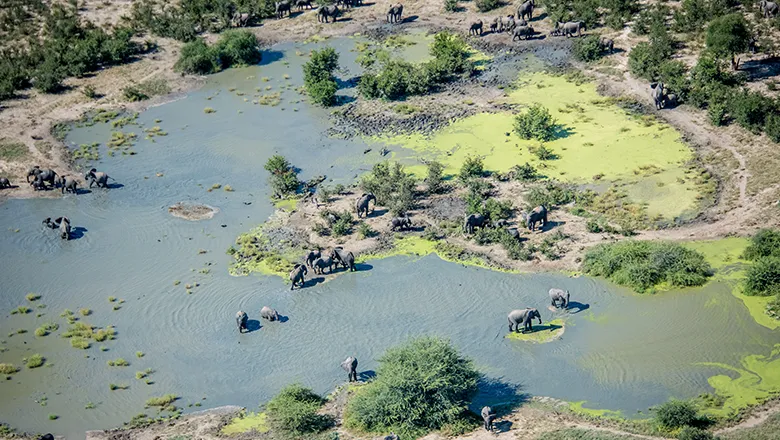An analysis using satellite data has provided compelling evidence that climate change-induced toxic algae blooms caused the mysterious deaths of 350 African elephants in Botswana during 2020. The research, led by King’s College London, reveals how an extreme shift from drought to heavy rains created deadly conditions in watering holes across Botswana’s Okavango Delta, one of Earth’s most important ecosystems.
Published in Science of The Total Environment | Estimated reading time: 7 minutes
When elephant carcasses began appearing across Botswana’s northeastern Okavango Delta in May and June 2020, it sparked global concern. The scale was unprecedented – 350 elephants dead, with their tusks intact, ruling out poaching. Now, through innovative use of satellite technology and spatial analysis, researchers have pieced together the ecological chain of events that led to this tragedy.
“Botswana is home to a third of all African elephants, and this unprecedented die-off within their largest remaining population underlines the escalating concerns surrounding the impact of drought and climate change on the Okavango Delta, one of the most important ecosystems in the world,” explains Davide Lomeo, a PhD student at King’s College London’s Department of Geography and the study’s lead author.
The investigation revealed a critical sequence of environmental events. As Lomeo describes: “Our analysis identified 20 waterholes near fresh carcasses that experienced increased algal bloom events in 2020 compared to the previous three years combined. These waterholes also exhibited the highest average algal biomass of the period 2015 – 2023.” The research team found that elephants likely walked an average of 16.5 kilometers from these toxic waterholes before succumbing within about 88 hours of exposure.
What made 2020 different was its extreme weather pattern. The region experienced its driest year in decades in 2019, followed by an extremely wet 2020. This dramatic shift, the researchers believe, triggered a devastating chain reaction. When heavy rains filled the dried waterholes, they stirred up sediments and nutrients that had accumulated during the drought, creating perfect conditions for explosive algal growth.
The study combined multiple lines of evidence to build its case. By analyzing satellite data of about 3,000 waterholes and comparing their conditions with the locations of deceased elephants, the team discovered that the deaths weren’t randomly distributed. Instead, they clustered around specific waterholes that showed unprecedented levels of algal growth.
The implications extend far beyond this single event. The research team warns that as Southern Africa becomes drier and hotter under climate change, waterholes across this region will likely be drier for more months of the year. “Our findings point to the potential negative effects on water quantity and quality, and the catastrophic repercussions on animals, this could have,” Lomeo explains.
The research demonstrates a powerful new approach to monitoring wildlife threats. By combining satellite monitoring with spatial analysis, scientists can now track water quality changes that might endanger wildlife, potentially allowing for earlier intervention when similar environmental threats emerge.
This tragic event serves as a stark warning about the complex ways climate change can impact wildlife. As the study concludes, it underscores the urgent need for comprehensive water quality surveillance across all waterbodies, including the smallest ones, to protect some of Earth’s most vulnerable species.
Key Terms
- Algal Bloom
- A rapid increase in algae population in water, often triggered by environmental conditions like increased nutrients and temperature.
- Spatial Analysis
- A scientific method that examines the locations, patterns, and relationships of geographic features and events.
- Hydrological Cycle
- The continuous movement of water within Earth and the atmosphere, including rainfall, evaporation, and groundwater processes.
Test Your Knowledge
How many waterholes showed unusual algal bloom activity during the elephant die-off?
The researchers identified 20 waterholes near fresh carcasses that experienced increased algal bloom events in 2020 compared to previous years.
What unique weather pattern preceded the 2020 die-off?
The region experienced its driest year in decades in 2019, followed by an extremely wet 2020, creating conditions that promoted unprecedented algal growth.
How far did affected elephants typically travel from toxic waterholes before dying?
The analysis showed elephants walked an average of 16.5 kilometers from the toxic waterholes and died within about 88 hours of exposure.
How might climate change affect similar events in the future?
As Southern Africa becomes drier and hotter, waterholes will likely be dry for longer periods, potentially leading to more frequent toxic algal blooms when rains return, threatening wildlife populations.
Enjoy this story? Subscribe to our newsletter at scienceblog.substack.com.
If our reporting has informed or inspired you, please consider making a donation. Every contribution, no matter the size, empowers us to continue delivering accurate, engaging, and trustworthy science and medical news. Independent journalism requires time, effort, and resources—your support ensures we can keep uncovering the stories that matter most to you.
Join us in making knowledge accessible and impactful. Thank you for standing with us!

